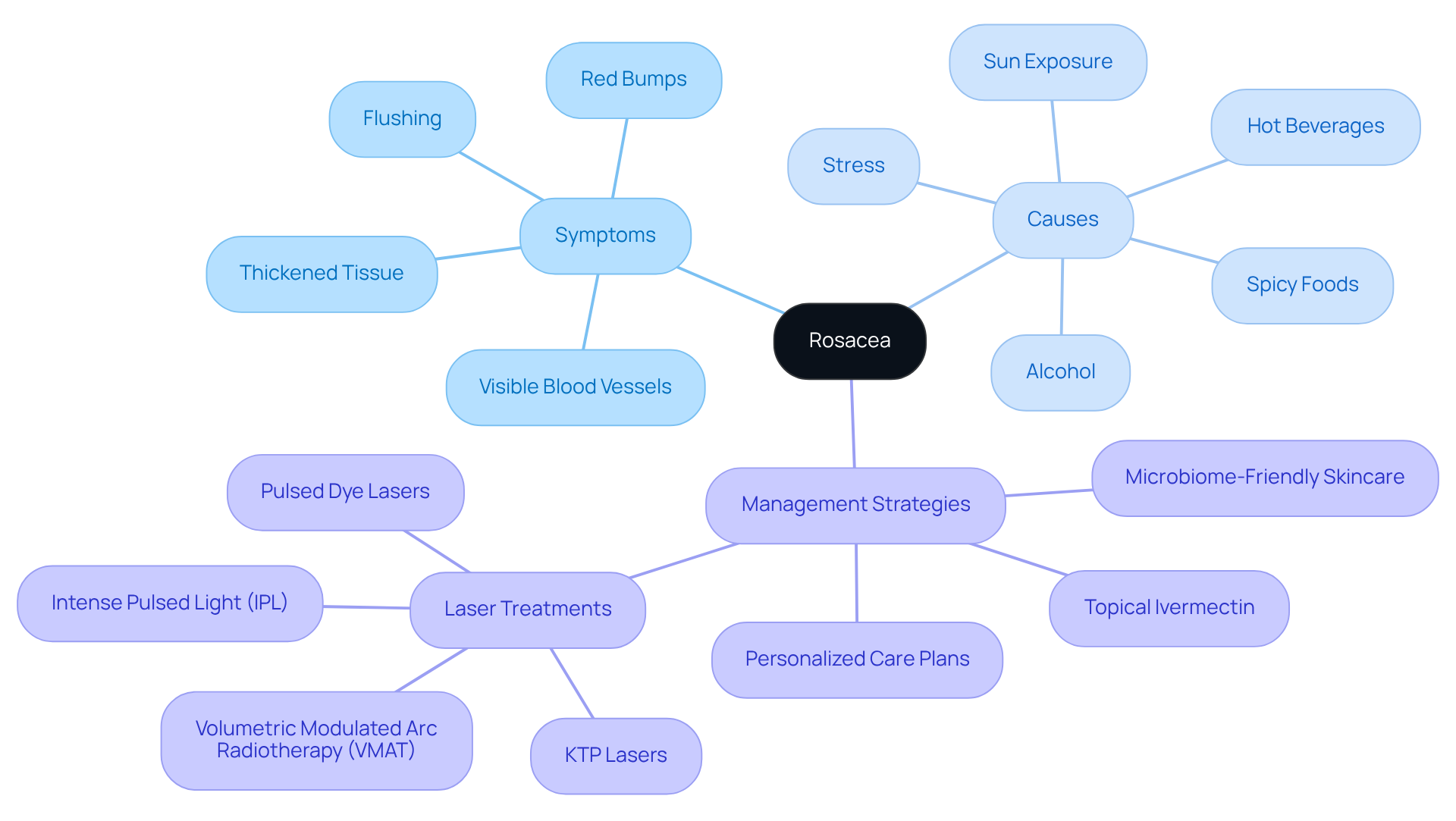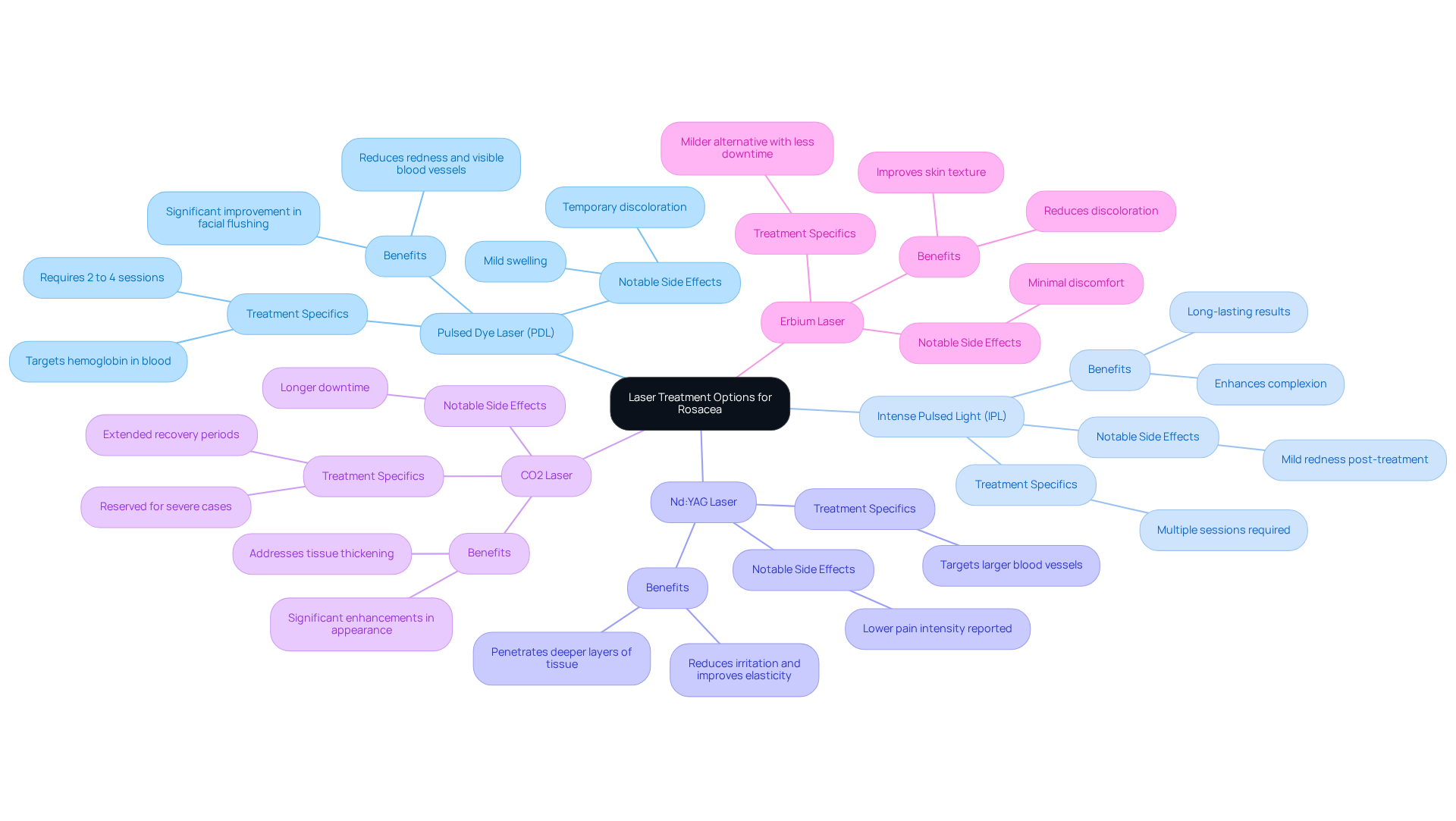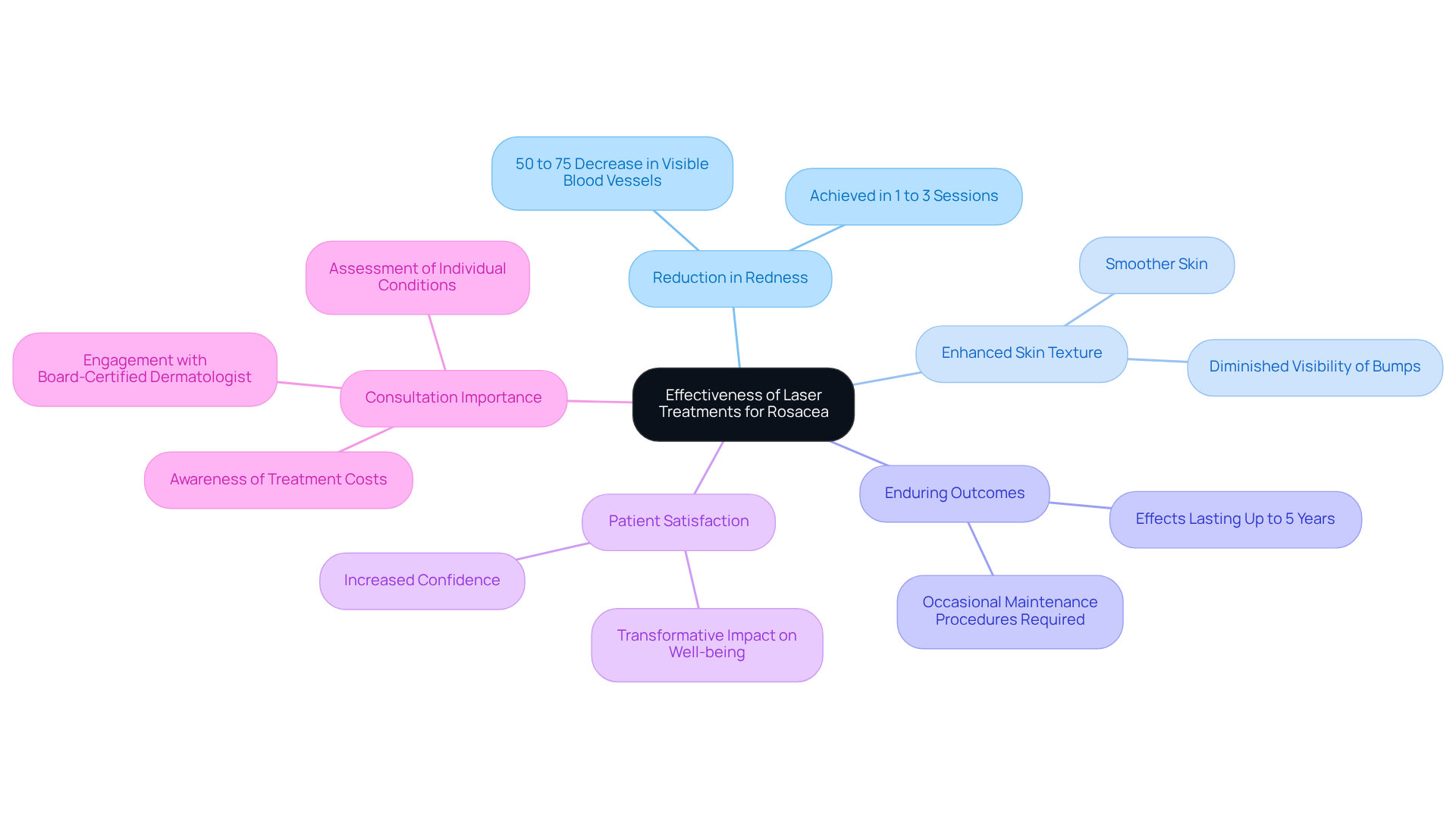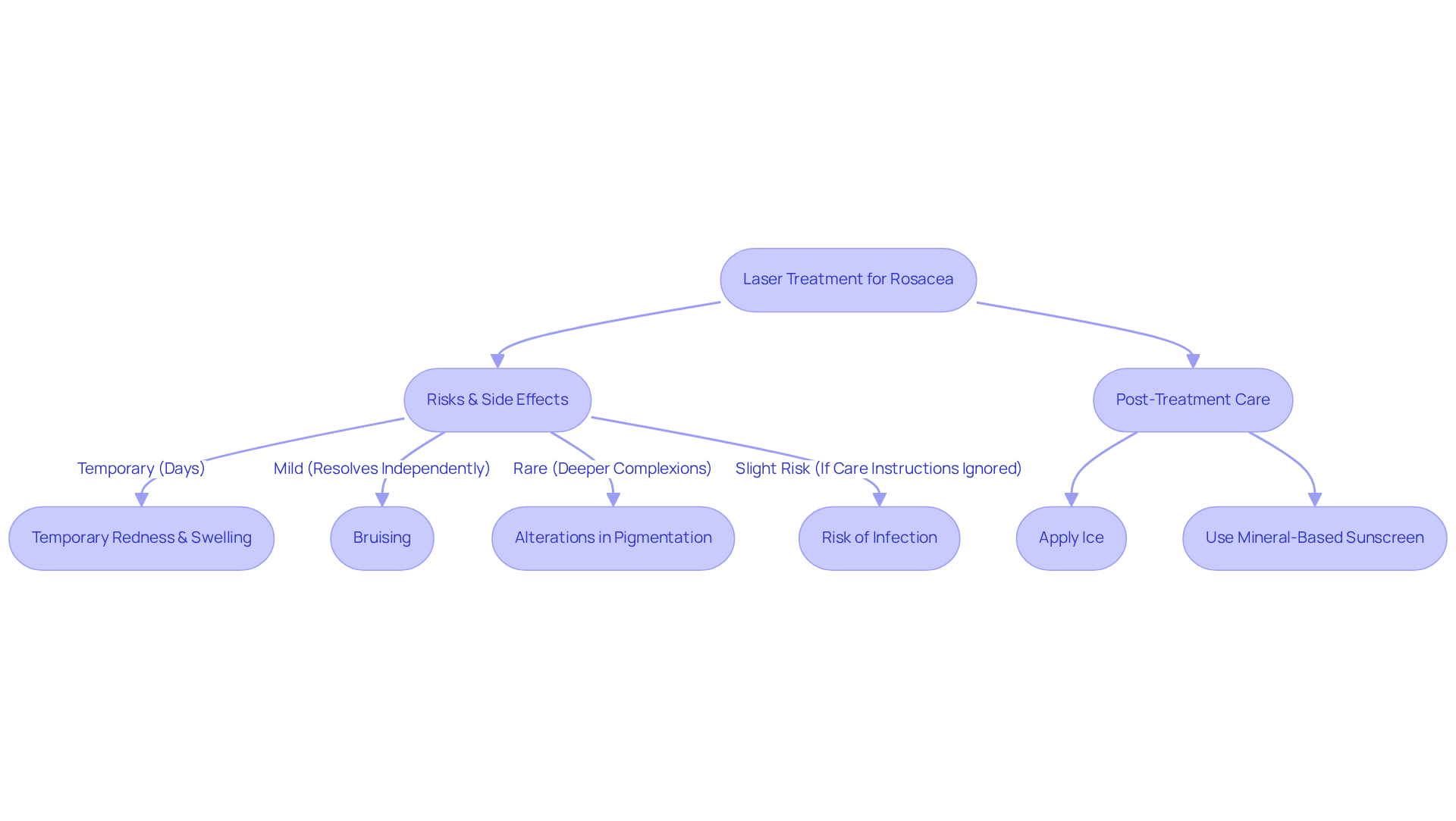Master Laser Treatment for Rosacea: Options, Effectiveness, and Risks

Overview
Laser treatment for rosacea presents a variety of effective options, notably including:
- Pulsed Dye Laser (PDL)
- Intense Pulsed Light (IPL)
- Nd:YAG Laser
These methods specifically target redness and visible blood vessels, with significant improvements reported by patients. While these treatments yield substantial benefits—such as reduced redness and improved skin texture—it's crucial to acknowledge potential risks.
- Temporary redness
- Swelling
- Pigmentation changes
These must be meticulously managed through personalized care plans and comprehensive post-treatment guidelines. By prioritizing individualized strategies, patients can maximize the advantages of laser therapy while minimizing adverse effects.
Introduction
Rosacea, a chronic skin condition impacting millions, poses unique challenges that can profoundly affect an individual's quality of life. Symptoms such as persistent redness and visible blood vessels necessitate the exploration of effective treatment options. This article investigates the promising realm of laser treatments for rosacea, examining various techniques, their effectiveness, and potential risks. As patients seek relief from this often misunderstood condition, a critical question emerges: can laser therapy deliver the lasting results they desire, or do the associated risks overshadow the benefits?
Define Rosacea: Symptoms and Causes
Rosacea is a persistent inflammatory condition that affects the face, marked by ongoing facial flushing, visible blood vessels, and, in some cases, acne-like bumps. The common symptoms include:
- Flushing, which manifests as frequent blushing or redness across the cheeks, nose, and forehead.
- Visible blood vessels, characterized by small, dilated blood vessels (telangiectasia) that become prominent on the surface.
- Red, inflamed bumps that may resemble acne.
- In advanced cases, thickened tissue, particularly on the nose (rhinophyma).
Although the precise cause of rosacea remains unclear, research suggests it may be triggered by various factors, including:
- Sun exposure
- Stress
- Hot beverages
- Spicy foods
- Alcohol
Recent studies have highlighted the significance of the gut-dermis axis and the dermal microbiome, indicating that imbalances in these areas can exacerbate symptoms. For instance, disturbances in the skin microbiome can lead to inflammation and sensitivity, making it essential to consider microbiome-friendly skincare products in management strategies.
Dermatologists emphasize the necessity for personalized care plans, as triggers can vary significantly among individuals. Certain foods or environmental factors may considerably worsen the condition for some. Notably, rosacea affects an estimated 10 percent of Caucasian and Asian populations, underscoring its prevalence.
Understanding these symptoms and triggers is crucial for effective management and planning, paving the way for targeted therapies such as laser treatment for rosacea that address the underlying vascular issues associated with the condition. Innovations in therapies, particularly laser treatment for rosacea and light therapies like pulsed dye lasers and intense pulsed light (IPL), have shown promise in alleviating symptoms with fewer side effects and shorter recovery times. As Professor Fogarty aptly states, "This isn’t just cosmetic - it’s deeply personal," underscoring the profound impact rosacea can have on one's quality of life.

Explore Laser Treatment Options for Rosacea
Laser treatments for rosacea are meticulously designed to target redness and visible blood vessels effectively, presenting several advanced options:
-
Pulsed Dye Laser (PDL): This treatment excels in reducing redness and visible blood vessels by specifically targeting hemoglobin in the blood. Research has demonstrated significant enhancements in facial flushing and a decreased frequency of symptom return after PDL therapy, establishing it as a preferred choice among dermatologists. Dr. Ritu emphasizes that laser treatment for rosacea may require 2 to 4 sessions to see results.
-
Intense Pulsed Light (IPL): In contrast to conventional lasers, IPL utilizes a broad spectrum of light to enhance complexion and diminish redness. It has shown long-lasting results, with numerous patients reporting substantial improvements in their rosacea symptoms after multiple sessions.
-
Nd:YAG Laser: Renowned for its ability to penetrate deeper layers of tissue, the Nd:YAG laser effectively addresses larger blood vessels associated with rosacea. Patients frequently experience reduced irritation on the surface and improved elasticity, contributing to the overall health of the dermis. Research indicates that individuals who received laser treatment for rosacea with the Nd:YAG laser reported lower pain intensity compared to those treated with PDL.
-
CO2 Laser: This option is typically reserved for more severe cases of rosacea, as it addresses tissue thickening and texture issues. Although it may require extended recovery periods, it can yield significant enhancements in appearance.
-
Erbium Laser: A milder alternative, the Erbium laser effectively improves skin texture and reduces discoloration without considerable downtime, making it suitable for individuals seeking less invasive solutions.
Each of these procedures, such as laser treatment for rosacea, may necessitate several sessions to achieve optimal outcomes. Dermatologists underscore the importance of customized care plans to effectively meet individual client needs. Potential side effects, such as temporary discoloration and swelling, should be discussed with your dermatologist to ensure a comprehensive understanding of the procedure. Furthermore, adhering to post-treatment care instructions is vital for optimal recovery and results.

Assess Effectiveness: Expected Results from Laser Treatments
Laser treatment for rosacea offers significant improvements, with many patients experiencing remarkable benefits.
-
Reduction in Redness is often reported, with individuals noting a 50% to 75% decrease in visible blood vessels after just 1 to 3 sessions. The Pulsed-Dye Laser (PDL) is recognized for its effectiveness in the laser treatment for rosacea, as it diminishes redness and visible blood vessels associated with the condition.
-
Enhanced Skin Texture is another advantage of these procedures, as they promote smoother skin and diminish the visibility of bumps, resulting in a more uniform complexion. The 1726 nm Accure Laser demonstrates promise for laser treatment for rosacea by specifically targeting sebaceous glands and inflammation in both papulopustular and phymatous types.
-
Enduring Outcomes are achievable, as the effects can persist for several years; however, the formation of new blood vessels may require occasional maintenance procedures to sustain results. Follow-up procedures are crucial to maintain the enhancements achieved.
-
Patient Satisfaction is noteworthy, with many individuals reporting increased confidence and contentment regarding their complexion post-treatment. This often leads to a transformative impact on their overall well-being. It is essential to recognize potential temporary side effects, such as increased redness and swelling, which typically resolve swiftly.
-
Consultation Importance cannot be overstated. Engaging with a board-certified dermatologist is vital to evaluate the suitability of laser therapy based on individual conditions and objectives. Furthermore, individuals should be mindful that laser treatments can be expensive and are frequently excluded from health insurance coverage, which may affect accessibility.
Individual outcomes can vary based on factors such as skin type, the severity of rosacea, and adherence to post-treatment care protocols. Clinical studies consistently show that individuals experience substantial improvements, underscoring the efficacy of laser treatment for rosacea in managing this chronic condition.

Understand Risks and Side Effects of Laser Treatments
Laser treatment for rosacea is widely recognized as safe; however, it entails specific risks and side effects that individuals must consider. Notably, patients may experience temporary redness and swelling immediately after treatment. These symptoms typically subside within a few days, with most individuals observing a significant reduction in discoloration within two weeks. Research indicates that increased redness following treatment generally fades within this timeframe.
Additionally, some patients may encounter bruising in the treated areas, which can vary in severity. This side effect is usually mild and resolves independently. Although less common, alterations in pigmentation may occur post-treatment, particularly in individuals with deeper complexions, who may face a heightened risk for this side effect. Furthermore, while rare, there exists a slight risk of infection if post-treatment care instructions are not meticulously followed.
Dermatologists emphasize the critical importance of adhering to post-treatment care guidelines to mitigate these risks. For instance, applying ice to the treated area can effectively soothe the skin, while mineral-based sunscreens are recommended to protect against sun exposure. As highlighted by specialists, consulting with a skilled dermatologist is essential to determine the most suitable and effective approach to care, which may include laser treatment for rosacea. It is also crucial to discuss your medical history and current medications with your healthcare provider before undergoing treatment, ensuring that patients are well-informed and prepared for the process.

Conclusion
Understanding rosacea is crucial for effective management, especially as advancements in laser treatments present promising solutions for those affected. This article has delved into the multifaceted nature of rosacea, covering its symptoms, triggers, and the various laser treatment options available. Each treatment method—such as Pulsed Dye Laser, Intense Pulsed Light, and Nd:YAG Laser—effectively targets the underlying vascular issues of rosacea, offering patients significant relief and an improved skin appearance.
The effectiveness of laser treatments is evident, with numerous individuals reporting substantial reductions in redness and visible blood vessels, as well as enhanced skin texture and overall satisfaction with their results. However, consulting with a qualified dermatologist is essential to navigate the potential risks and side effects associated with these treatments. This ensures a personalized approach that considers individual conditions and goals.
Ultimately, the journey toward managing rosacea through laser treatment not only enhances physical appearance but also significantly improves quality of life. For those grappling with this condition, seeking professional guidance and exploring the latest advancements in laser therapies can pave the way to a more confident and fulfilling life. Taking proactive steps in treatment can lead to lasting benefits, reinforcing the importance of addressing rosacea head-on.
Frequently Asked Questions
What is rosacea?
Rosacea is a persistent inflammatory condition that primarily affects the face, characterized by ongoing facial flushing, visible blood vessels, and, in some cases, acne-like bumps.
What are the common symptoms of rosacea?
Common symptoms of rosacea include flushing (frequent blushing or redness across the cheeks, nose, and forehead), visible blood vessels (small, dilated blood vessels on the surface), red inflamed bumps resembling acne, and in advanced cases, thickened tissue, particularly on the nose (rhinophyma).
What causes rosacea?
The precise cause of rosacea is unclear, but it may be triggered by factors such as sun exposure, stress, hot beverages, spicy foods, and alcohol. Recent studies also suggest that imbalances in the gut-dermis axis and the dermal microbiome can exacerbate symptoms.
How does the microbiome relate to rosacea?
Disturbances in the skin microbiome can lead to inflammation and sensitivity, highlighting the importance of considering microbiome-friendly skincare products in managing rosacea.
How prevalent is rosacea?
Rosacea affects an estimated 10 percent of Caucasian and Asian populations, indicating its significant prevalence.
Why is personalized care important for rosacea patients?
Personalized care plans are essential because triggers can vary significantly among individuals, meaning that certain foods or environmental factors may worsen the condition for some people.
What are some effective treatments for rosacea?
Targeted therapies such as laser treatment and light therapies like pulsed dye lasers and intense pulsed light (IPL) have shown promise in alleviating symptoms with fewer side effects and shorter recovery times.
How does rosacea impact quality of life?
Rosacea can have a profound impact on one's quality of life, as highlighted by Professor Fogarty, who noted that 'this isn’t just cosmetic - it’s deeply personal.'


